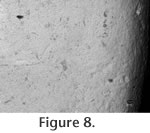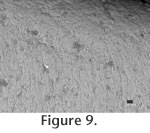| |
Discussion of Microwear Patterns
 The pattern of microwear along each of the three maxillae examined was consistent (Figure 4 and
Figure 5). Independently, Vincent Williams, a
Postgraduate Researcher currently at the University of Leicester, examined a hadrosaur
maxillary from the Belly River Formation of Alberta and noted a similar pattern
for that specimen (see
What Dinosaurs Eat). Therefore, the prediction implied by
Horner et al. (2004) bears out regarding microwear patterns, and the use of isolated teeth as a proxy for individual animals is valid. The pattern of microwear along each of the three maxillae examined was consistent (Figure 4 and
Figure 5). Independently, Vincent Williams, a
Postgraduate Researcher currently at the University of Leicester, examined a hadrosaur
maxillary from the Belly River Formation of Alberta and noted a similar pattern
for that specimen (see
What Dinosaurs Eat). Therefore, the prediction implied by
Horner et al. (2004) bears out regarding microwear patterns, and the use of isolated teeth as a proxy for individual animals is valid.
 Given that dentine and enamel are of different hardness it is expected that each material will show a different pattern of wear. Indeed, for theropod teeth it was noted that dentine microwear patterns were more developed than microwear patterns observed in the enamel of similar theropod teeth (Fiorillo 2006b,
2008). Such a pattern holds true as well for the hadrosaur teeth used in this study.
Figure 6 shows wear on a tooth from the Aguja Formation of west Texas. This tooth is representative of the discussion here. Given that dentine and enamel are of different hardness it is expected that each material will show a different pattern of wear. Indeed, for theropod teeth it was noted that dentine microwear patterns were more developed than microwear patterns observed in the enamel of similar theropod teeth (Fiorillo 2006b,
2008). Such a pattern holds true as well for the hadrosaur teeth used in this study.
Figure 6 shows wear on a tooth from the Aguja Formation of west Texas. This tooth is representative of the discussion here.
 The dentine is the lighter gray area to the left of the image and shows an abundance of scratches compared to the nearly vertical band of darker gray enamel. Further, there is a broad scratch near the top of the image that is prominent in the dentine but loses definition in the enamel. Therefore, although somewhat intuitive given the softer nature of dentine compared to enamel, it is only appropriate in further comparisons to use either dentine wear or enamel wear to compare between teeth. The dentine is the lighter gray area to the left of the image and shows an abundance of scratches compared to the nearly vertical band of darker gray enamel. Further, there is a broad scratch near the top of the image that is prominent in the dentine but loses definition in the enamel. Therefore, although somewhat intuitive given the softer nature of dentine compared to enamel, it is only appropriate in further comparisons to use either dentine wear or enamel wear to compare between teeth.
 Pits are considered to indicate the consumption of harder food items (Teaford 1985;
Taylor and Hannam 1987;
Walker and Teaford 1989;
Ungar 1994;
Fiorillo 1998). Pits were not commonly observed on the teeth examined (Figure 4,
Figure 5,
Figure 6,
Figure 7,
Figure 8,
Figure 9, and
Figure 10;
Table 3). Pits are considered to indicate the consumption of harder food items (Teaford 1985;
Taylor and Hannam 1987;
Walker and Teaford 1989;
Ungar 1994;
Fiorillo 1998). Pits were not commonly observed on the teeth examined (Figure 4,
Figure 5,
Figure 6,
Figure 7,
Figure 8,
Figure 9, and
Figure 10;
Table 3).
 As predicted given the relative softness of dentine compared to enamel, the incidence of pitting was higher on dentine surfaces than on enamel surfaces. Further, the incidence of pitting remained relatively consistent independent of locality. Hence, this analysis suggests that hadrosaurs were consuming food items of similar hardness independent of latitude. In addition, scratch and pit density per tooth showed some variation within localities (e.g., compare
Figure 7 with
Figure 10). Such a variation may indicate either additional time chewing or the consumption of the occasional food item of a different hardness.
Valdez and Krausman (1999) point out that given the wide geographic range of Ovis, it is reasonable to expect a great deal of breadth in food items consumed. As predicted given the relative softness of dentine compared to enamel, the incidence of pitting was higher on dentine surfaces than on enamel surfaces. Further, the incidence of pitting remained relatively consistent independent of locality. Hence, this analysis suggests that hadrosaurs were consuming food items of similar hardness independent of latitude. In addition, scratch and pit density per tooth showed some variation within localities (e.g., compare
Figure 7 with
Figure 10). Such a variation may indicate either additional time chewing or the consumption of the occasional food item of a different hardness.
Valdez and Krausman (1999) point out that given the wide geographic range of Ovis, it is reasonable to expect a great deal of breadth in food items consumed.
 The variations in wear observed here may likewise be attributed to a function of the broad geographic area occupied by these hadrosaurs. The variations in wear observed here may likewise be attributed to a function of the broad geographic area occupied by these hadrosaurs.
A good deal of attention has been directed at scratch orientations in microwear studies to understand aspects of jaw mechanics and dietary preferences. When scratches predominate it is typically inferred to indicate a degree of jaw translation in the power stroke. With respect to hadrosaurs, tooth wear parameters have been shown to be best predicted by a hinge-like articulation between the maxilla and associated elements against the premaxilla and skull roof (Weishampel 1984). This mechanism, termed pleurokinesis (Norman 1984), provides a transverse power stroke through the lateral rotation of the maxillae in concert with the continuous upward movement of the lower jaws.
Weishampel (1984) noted microstriae have a transverse orientation along inclined occlusal surfaces in hadrosaurs, that the wear was mirrored on both sides of maxillary and dentary teeth, and that wear striae are oriented approximately 79°-82° distally from the transverse axis of the tooth.
Table 3 includes the length of the mean striation vector, which is a measure of the concentration of the orientations of the long axis of each linear feature of 10 representative teeth in the sample. The values in the table are less than conclusive regarding a preferred orientation for the striae examined on each tooth. This discrepancy may reflect that at higher magnifications (1000 X) the inclusion of very small striae obscures the more dominant pattern discussed by others (Weishampel 1984;
Horner et al. 2004). Regardless of the cause of this discrepancy, there seems to be little difference between the geographic regions to justify further discussion.
|





